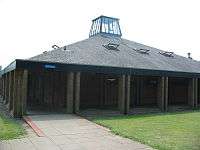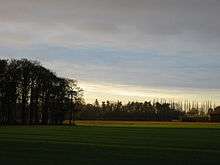Wymondham College
|
The logo of Wymondham College | |
| Motto |
Floreat Sapientia (Let Wisdom Flourish) |
|---|---|
| Established | 1951 |
| Type |
Academy Day and boarding school |
| Principal | Mr Jonathan Taylor |
| Founder | Lincoln Ralphs |
| Location |
Golf Links Road Morley Wymondham Norfolk NR18 9SZ England Coordinates: 52°32′42″N 1°03′26″E / 52.54489°N 1.05736°E |
| DfE URN | 136481 Tables |
| Ofsted | Reports Pre-academy reports |
| Students | 1,262 |
| Gender | Coeducational |
| Ages | 11–18 |
| Houses |
Y7-Y11: Cavell Hall, Fry Hall, Kett Hall, New Hall, Peel Hall Y12-Y13: Lincoln Hall |
| Publication | Wymondham College Magazine |
| Former pupils | Old Wymondhamians |
| Website |
www |
Wymondham College is a coeducational secondary school with academy status in Wymondham, Norfolk, England. A former grammar school, it is one of 36 state boarding schools in England and the largest of its type in the country, with up to 700 boarding places. Although boarders do not pay for their education in the same way as at an independent school, they are still required to pay for the costs of living at the school (£10,000) whereas day pupils attend the school for free.[1] It has specialisms in technology (maths, science, ICT & Design Technology) and in modern languages. It is one of the highest performing state schools in England and Wales. In 2015 it was the top performing state school in East Anglia. In 2016 The DfE recognised the College as being in the top 100 schools nationally on each the main three measures, attainment, EBACC pass rate and Value added progress. The college was awarded world class school status in November 2015.
History
Former Military Hospital
The School is built on the site of the Second World War USAAF 231st Station Hospital, and when the school first opened in 1951 the hospital's forty Nissen huts were used as classrooms and dormitories. It was established by Lincoln Ralphs, the chief education officer of Norfolk County Council. Brick-built accommodation began to appear in the late 1950s, but Nissen huts remained in use,[2] principally for classrooms and storage, through to end of the 1990s. The only Nissen hut now remaining is the College chapel. A memorial garden has been created on the site of the former USAAF mortuary, which for many years was used as the school's technical drawing classroom.
Grammar schools
In 1951 there were two separate schools, Grammar and Technical, each with separate Heads. They merged in the mid-1950s after an uneasy co-existence. The school was a co-educational boarding grammar school. It was intended for academically-gifted children in remote rural areas with no grammar schools in their local area that they could attend, as well as those with parents abroad or who regularly moved around the country. It gave priority, where possible, to children from families where the parents had separated, thus possibly under financial hardship. Admissions were by examination and headmasters' reports.
In January 1958, a hoard of 881 Anglo Saxon (Edward the Elder) coins were found at the school when a drain was being dug.
In the mid-1970s, the school had 700 boarders and 750 day pupils (from the former county grammar school). By 1978 this was 1,000 day pupils as well as the 700 boarders. Margaret Thatcher visited the school in the early 1970s.
The school remained exclusively 'boarding' until the early 1970s, when it was merged with the County Grammar School, which had been hosted at Wymondham on a 'temporary' basis for the best part of ten years.
The school in the 1970s had been in a state of disrepair with an out-dated water supply and drainage system, and had an unreliable heating system (built by the USAF in 1944) in the winter and lack of insulation. Despite these problems it was still producing outstanding academic results. It was offered £250,000 in 1978 by the Labour government to address the situation, on condition that the school became a comprehensive school. The money never appeared, partly because soon after Labour lost the 1979 general election.
Comprehensive
Grammar school status was lost with the advent of comprehensive education. In the early 1990s it became a grant maintained school.
The facilities are used for external summer schools. In August 1998, seven children from London on a course run by a special needs charity were taken to the Norfolk and Norwich Hospital after being stung by a swarm of non-native Median wasps. On 9 March 1990, the Duke of Edinburgh visited the school.
Academy
In 2010 the school became an academy as part of the Academies Act 2010.
Premises

The accommodation blocks (in order of construction) are:
- Peel Hall: after Alderman Sam Peel – former Chairman of Norfolk Education Committee.
- Lincoln Hall: after Abraham Lincoln, in honour of the servicemen who were hospitalised there before it became a school. Opened by US Secretary Of State Dean Acheson.
- Fry Hall: after Elizabeth Fry.
- Kett Hall: after Robert Kett.
- Cavell Hall: after Edith Cavell.
- New Hall: last of the modern Houses to be built.
- Lincoln Ralphs Sixth Form Centre; After Sir Lincoln Ralphs, former Chief Education Officer for Norfolk and the founding father of the College.
The grouping of Houses into Halls varied over time.
A recent major development includes a football AstroTurf pitch with floodlights, nine new classrooms, two new science laboratories (linking the old part of the science block with the newer part) and infill to Peel boarding house roof for additional dormitories. A new dining room extension includes the admin block and new staff room. Peel Hall has increased capacity with departure of the staffroom and admin to the new building.
Another recent major development is a new International Centre which was built to replace the old Language Block which was a Morgue in World War Two. The old Language block is then due to become the new administration centre. The International Centre houses Modern Foreign Languages Block and the UK office of the Model European Parliament. It was completed in June 2011.
House system
A House system was first established in 1953, with house names North, South, East and West. As the College expanded and brick-built accommodation came into use in the early 1960s, the system was revised and the Houses were given names of Cathedral towns and cities:
- Boys: York, Gloucester, Canterbury, Norwich, Durham, Salisbury
- Girls: Wells, Westminster, Worcester, Winchester (with Wakefield and Washington added later)
When mixed Houses were introduced in the early 1970s, the cathedral House names were scrapped and the Houses adopted the names of the Halls themselves. Lincoln and Peel Halls were converted to Sixth Form boarding houses in 1978, Peel Hall being further converted into a boarding house for Year Sevens in 1995.
The house system was as follows:
- Year Seven: Peel
- Years Eight to Eleven: Fry, Cavell, Kett or New
- Years Twelve to Thirteen: Lincoln
As of the 2010–2011 academic year, Peel started to retain some year 7 students in order to become a 'main school house'. Under the new system, the houses appear so:
- Years Seven to Eleven: Cavell, Kett, Fry, New or Peel
- Years Twelve to Thirteen: Lincoln
Notable Old Wymondhamians

- Stephen Byers, Labour MP for North Tyneside from 1992 until 2010, former Chief Secretary to the Treasury, Secretary of State for Trade and Industry, and Secretary of State for Transport, Local Government and the Regions in the Cabinet
- Colin Self, artist (1952–1959)
- Trudy Stevenson, Zimbabwe Ambassador to Senegal (1955–1962)
- Peter Rogers CBE, Chief Executive since 2003 of Babcock International Group plc (1959–1966)
- Patsy Calton Lib Dem for MP for Cheadle from 2001–2005 (1960–1967)
- Mark Brayne, BBC foreign correspondent and psychotherapist
- Nicholas Crane, explorer and writer (1965–1972)
- Norman Lamb, Liberal Democrat MP from 2001 for North Norfolk, Minister of State for Care and Support (1969–76)
- Justin Edrich, cricketer (1972–1977)
- Mike Gascoyne, Technical Director of Lotus F1 Racing (1974–1981)
- Mark Strong, actor in Our Friends in the North, and narrator of Who Do You Think You Are (2006–2012)
- Adam Rayner, actor in Mistresses (1998)
- Will Evans, rugby union player for Leicester Tigers (2016-present)
Wymondham Grammar School
- Sir Frederick William Wilson, Liberal MP from 1895–1906 for Mid Norfolk (1855–62)
References
- ↑ "Boarding". Wymondham College. Retrieved 17 November 2012.
- ↑ geograph.org.uk photograph
- Guardian 7 March 1978, page 13
- Guardian 27 July 1982, page 11
External links
News items
- Wymondham College apologises over pupils' data breach in January 2014
- Paralympian receives Wymondham College award in October 2012
- Head makes the case for boarding schools in May 2009
- Teacher claimed discrimination in April 2005
